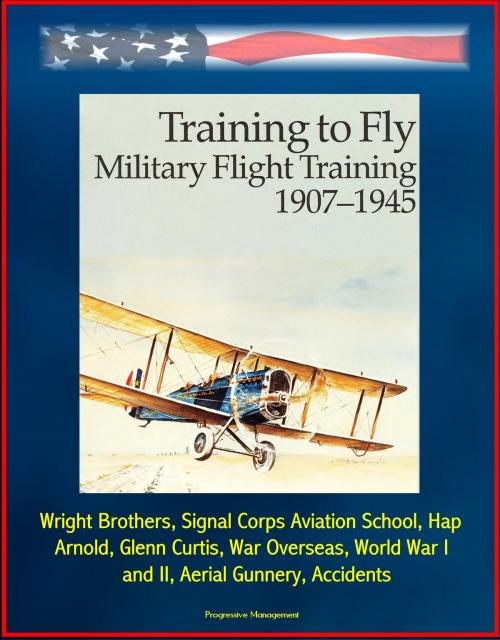Training to Fly: Military Flight Training 1907 - 1945 - Wright Brothers, Signal Corps Aviation School, Hap Arnold, Glenn Curtis, War Overseas, World War I and II, Aerial Gunnery, Accidents
Nonfiction, Science & Nature, Technology, Aeronautics & Astronautics, History, Military, Aviation| Author: | Progressive Management | ISBN: | 9781311916211 |
| Publisher: | Progressive Management | Publication: | August 30, 2015 |
| Imprint: | Smashwords Edition | Language: | English |
| Author: | Progressive Management |
| ISBN: | 9781311916211 |
| Publisher: | Progressive Management |
| Publication: | August 30, 2015 |
| Imprint: | Smashwords Edition |
| Language: | English |
Professionally converted for accurate flowing-text e-book format reproduction, this fascinating Air Force book is an institutional history of flight training by the predecessor organizations of the United States Air Force. The U.S. Army purchased its first airplane, built and successfully flown by Orville and Wilbur Wright, in 1909, and placed both lighter- and heavier-than-air aeronautics in the Division of Military Aeronautics of the Signal Corps. As pilots and observers in the Air Service of the American Expeditionary Forces, Americans flew combat missions in France during the Great War. In the first postwar decade, airmen achieved a measure of recognition with the establishment of the Air Corps and, during World War II, the Army Air Forces attained equal status with the Army Ground Forces. During this first era of military aviation, as described by Rebecca Cameron in Training to Fly, the groundwork was laid for the independent United States Air Force. Those were extraordinarily fertile years of invention and innovation in aircraft, engine, and avionics technologies. It was a period in which an air force culture was created, one that was a product of individual personalities, of the demands of a technologically oriented officer corps who served as the fighting force, and of patterns of professional development and identity unique to airmen. Most critical, a flight training system was established on firm footing, whose effective test came in combat in World War II, and whose organization and methods continue virtually intact to the present day. This volume is based primarily on official documents that are housed in the National Archives and Records Administration. Some, dating from World War II, remained unconsulted and languishing in dust-covered boxes until the author's research required that they be declassified. She has relied upon memoirs and other first-person accounts to give a human face to training policies as found in those dry, official records. Training to Fly is the first definitive study of this important subject. Training is often overlooked because operations, especially descriptions of aerial combat, have attracted the greatest attention of scholars and the popular press. Yet the success of any military action, as we have learned over and over, is inevitably based upon the quality of training. That training is further enhanced by an understanding of its history, of what has failed, and what has worked.
PART I - The First Decade, 1907-1917 * CHAPTER ONE - Beginnings: Men and Machines * Institutional and Intellectual Underpinnings of Military Aviation * Airplane Trials * Training the Army to Fly * A One-man, One-plane Training Air Force * New Airplanes, New Men * First Tactical Organization * CHAPTER TWO - The Signal Corps Aviation School * College Park, Maryland * Augusta, Georgia * Diversification * North Island, California * Growing Pains * CHAPTER THREE - Prelude to War: Reform, Operational Training, Preparedness * The Case before Congress * Training Excursions into the Field * Struggling Out of Isolation * Breakout * On the Brink of War * PART II - The End of Illusions * CHAPTER FOUR - Training at Home for War Overseas * Ground Schools * Primary Flying Training * Advanced Flying Training * Pursuit * Observation * Bombardment * Too Little, Too Late * CHAPTER FIVE - Air Service, American Expeditionary Forces * Primary Training * Advanced Training * Specialized Training * Pursuit * Observation * Bombardment * Aerial Gunnery * Unit Training * Looking Back * PART III - Peace * CHAPTER SIX - Postwar Retrenchment * Organization * Flight Training * Primary Flying School * Advanced Flying School * Specialized Training * Observation * Pursuit * Attack * Bombardment * Tactical Unit Training * Early Recovery * CHAPTER SEVEN - Boom and Bust: The Air Corps Years * Planning and Organization * The Air Corps Training Center
Professionally converted for accurate flowing-text e-book format reproduction, this fascinating Air Force book is an institutional history of flight training by the predecessor organizations of the United States Air Force. The U.S. Army purchased its first airplane, built and successfully flown by Orville and Wilbur Wright, in 1909, and placed both lighter- and heavier-than-air aeronautics in the Division of Military Aeronautics of the Signal Corps. As pilots and observers in the Air Service of the American Expeditionary Forces, Americans flew combat missions in France during the Great War. In the first postwar decade, airmen achieved a measure of recognition with the establishment of the Air Corps and, during World War II, the Army Air Forces attained equal status with the Army Ground Forces. During this first era of military aviation, as described by Rebecca Cameron in Training to Fly, the groundwork was laid for the independent United States Air Force. Those were extraordinarily fertile years of invention and innovation in aircraft, engine, and avionics technologies. It was a period in which an air force culture was created, one that was a product of individual personalities, of the demands of a technologically oriented officer corps who served as the fighting force, and of patterns of professional development and identity unique to airmen. Most critical, a flight training system was established on firm footing, whose effective test came in combat in World War II, and whose organization and methods continue virtually intact to the present day. This volume is based primarily on official documents that are housed in the National Archives and Records Administration. Some, dating from World War II, remained unconsulted and languishing in dust-covered boxes until the author's research required that they be declassified. She has relied upon memoirs and other first-person accounts to give a human face to training policies as found in those dry, official records. Training to Fly is the first definitive study of this important subject. Training is often overlooked because operations, especially descriptions of aerial combat, have attracted the greatest attention of scholars and the popular press. Yet the success of any military action, as we have learned over and over, is inevitably based upon the quality of training. That training is further enhanced by an understanding of its history, of what has failed, and what has worked.
PART I - The First Decade, 1907-1917 * CHAPTER ONE - Beginnings: Men and Machines * Institutional and Intellectual Underpinnings of Military Aviation * Airplane Trials * Training the Army to Fly * A One-man, One-plane Training Air Force * New Airplanes, New Men * First Tactical Organization * CHAPTER TWO - The Signal Corps Aviation School * College Park, Maryland * Augusta, Georgia * Diversification * North Island, California * Growing Pains * CHAPTER THREE - Prelude to War: Reform, Operational Training, Preparedness * The Case before Congress * Training Excursions into the Field * Struggling Out of Isolation * Breakout * On the Brink of War * PART II - The End of Illusions * CHAPTER FOUR - Training at Home for War Overseas * Ground Schools * Primary Flying Training * Advanced Flying Training * Pursuit * Observation * Bombardment * Too Little, Too Late * CHAPTER FIVE - Air Service, American Expeditionary Forces * Primary Training * Advanced Training * Specialized Training * Pursuit * Observation * Bombardment * Aerial Gunnery * Unit Training * Looking Back * PART III - Peace * CHAPTER SIX - Postwar Retrenchment * Organization * Flight Training * Primary Flying School * Advanced Flying School * Specialized Training * Observation * Pursuit * Attack * Bombardment * Tactical Unit Training * Early Recovery * CHAPTER SEVEN - Boom and Bust: The Air Corps Years * Planning and Organization * The Air Corps Training Center















